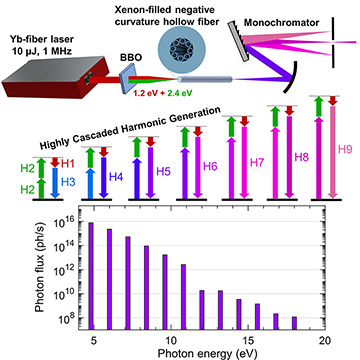 Highly cascaded harmonic generation in a unique, high-flux ultrafast VUV source. [Enlarge figure]
Highly cascaded harmonic generation in a unique, high-flux ultrafast VUV source. [Enlarge figure]
The vacuum ultraviolet (VUV) spectral region, from around 6 to 15 eV, is uniquely able to probe physical and chemical processes, since the ionization energies of nearly all molecules and materials lie in this energy range. As a result, many cutting-edge spectroscopies harness VUV light. These include angle-resolved photoemission spectroscopy (ARPES), which studies the electronic structure of materials and surfaces, and photoionization mass spectrometry (PIMS), which identifies molecules in complex mixtures.
Unfortunately, the scope for such experiments is limited, as few sources of high-flux VUV beams exist. Synchrotron facilities provide bright VUV light at a high pulse repetition rate, with high energy resolution across a wide range of photon energies.1 These facilities have limited access, however, and scientists must travel to them with their samples. Deuterium lamps can reach into the VUV region, to around 10 eV, but are too dim for many applications when used with a monochromator. Finally, the ninth harmonic of a Nd:YAG laser can provide bright, coherent and monochromatic beams in a simple, robust setup—but at a low repetition rate.2
An ideal VUV light source for applications in ARPES and PIMS would have a high flux, a high repetition rate (MHz), a photon energy range from the UV to at least 15 eV, and variable energy and time resolution. This year, we reported a highly cascaded harmonic generation (HCHG) technique that addresses this challenge.3 The system produces UV and VUV spectral lines through the upconversion of an infrared fiber laser, such that each harmonic contributes to the formation of even higher harmonics.
By focusing two colors (the fundamental and second harmonic of a 10-W average power Yb:fiber laser) into a xenon-filled, negative-curvature hollow-core fiber, and by tuning the xenon pressure to provide optimal phase-matching, we have generated both even and odd harmonic orders ranging from the 3rd to the 15th. The peak intensity required for this process was approximately 2x1012 W/cm2, some 50 times lower than that required for conventional high-harmonic generation. As expected for a perturbative cascaded interaction, the flux at each harmonic decreases with increasing harmonic order. Yet at 1012 to 1016 photons per second, this source rivals similar-bandwidth synchrotrons at photon energies up to 10.8 eV.
The high repetition rate of this VUV source can minimize space-charge effects, false coincidences and detector dead times. Finally, the small VUV source size permits high energy resolution when needed with a compact monochromator. This resolution is critical for resolving closely spaced spectral bands or providing unambiguous target identification.
Researchers
David E. Couch* and Margaret M. Murnane, University of Colorado at Boulder, CO, USA
Daniel D. Hickstein, KMLabs Inc., Boulder, CO, USA
Henry C. Kapteyn, University of Colorado at Boulder and KMLabs Inc., Boulder, CO, USA
*Present address: Sandia National Laboratories, USA.
References
1. D. Osborn et al. Rev. Sci. Instrum. 79, 104103 (2008).
2. N. Lockyer et al. Laser Chem. 17, 139 (1997).
3. D.E. Couch et al. Optica 7, 832 (2020).
